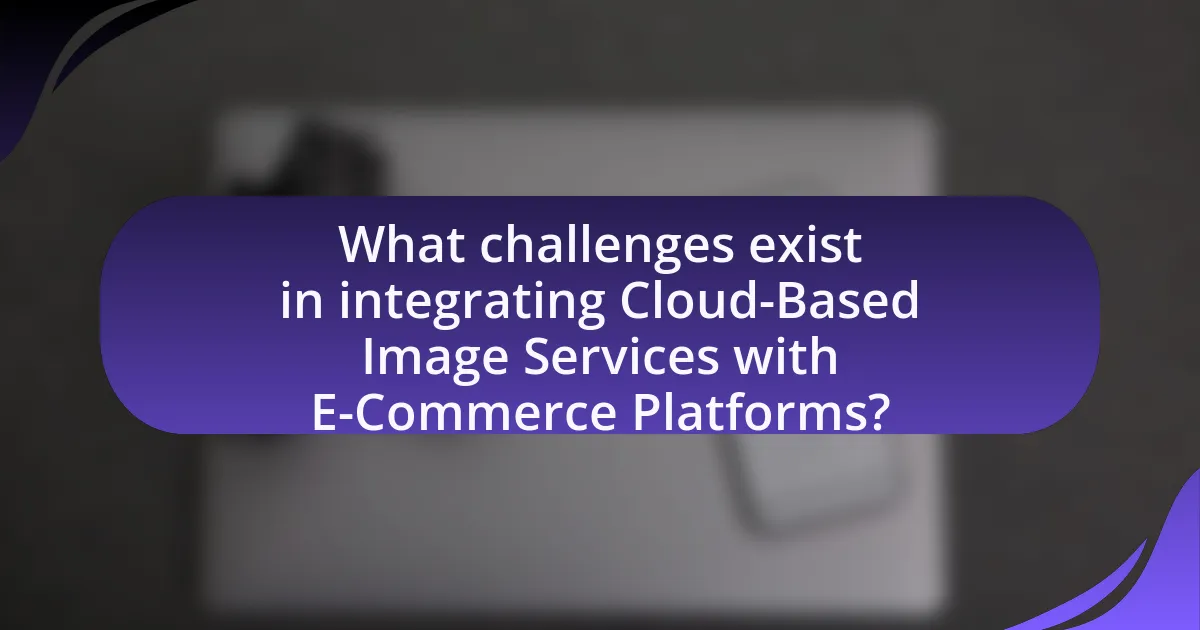Cloud-based image services are online platforms that facilitate the storage, processing, and management of digital images through cloud computing technology. This article explores the functionality of these services, the technologies involved, and their advantages for e-commerce businesses, including scalability, cost-effectiveness, and improved user experience. It also addresses the integration process with existing e-commerce platforms, highlighting common challenges, best practices, and the importance of ongoing maintenance. Additionally, the article discusses the impact of image quality on online sales and provides insights into measuring the success of integration efforts.
What are Cloud-Based Image Services?

Cloud-based image services are online platforms that provide storage, processing, and management of digital images through cloud computing technology. These services enable users to upload, store, and access images from any device with internet connectivity, facilitating easy sharing and collaboration. According to a report by MarketsandMarkets, the global cloud-based image services market is expected to grow significantly, driven by the increasing demand for digital content and the need for scalable storage solutions.
How do Cloud-Based Image Services function?
Cloud-based image services function by storing, processing, and delivering images over the internet through remote servers. These services utilize cloud computing technology to enable users to upload images, which are then stored in a centralized location, allowing for easy access and management from any device with internet connectivity.
The processing capabilities of these services often include image resizing, format conversion, and optimization for web use, which enhances loading times and user experience on e-commerce platforms. Additionally, cloud-based image services typically offer APIs that facilitate integration with various applications, enabling seamless workflows for businesses.
For instance, according to a report by MarketsandMarkets, the global cloud-based image processing market is projected to grow significantly, indicating the increasing reliance on such services for efficient image management and delivery in e-commerce.
What technologies are involved in Cloud-Based Image Services?
Cloud-Based Image Services utilize several key technologies, including cloud storage, image processing algorithms, and application programming interfaces (APIs). Cloud storage enables the scalable and secure storage of images, allowing users to access and manage their images from anywhere. Image processing algorithms facilitate tasks such as resizing, filtering, and enhancing images, which are essential for optimizing visual content. APIs provide the necessary interfaces for integrating these services with e-commerce platforms, enabling seamless uploads, retrievals, and manipulations of images. These technologies collectively enhance the functionality and user experience of cloud-based image services in e-commerce environments.
How do these technologies enhance image processing?
Cloud-based image services enhance image processing by providing scalable storage, advanced algorithms, and real-time processing capabilities. These technologies enable e-commerce platforms to efficiently manage large volumes of images, apply machine learning techniques for image recognition, and optimize images for faster loading times. For instance, cloud services can automatically adjust image resolution and format based on user device specifications, improving user experience and engagement. Additionally, the integration of artificial intelligence in these services allows for automated tagging and categorization of images, which streamlines inventory management and enhances search functionality on e-commerce sites.
What advantages do Cloud-Based Image Services provide?
Cloud-Based Image Services provide scalability, cost-effectiveness, and accessibility. These services allow businesses to store and manage large volumes of images without the need for extensive on-premises infrastructure, which reduces operational costs. For instance, companies can pay only for the storage and bandwidth they use, leading to significant savings compared to traditional storage solutions. Additionally, cloud-based services enable users to access images from anywhere with an internet connection, facilitating collaboration and enhancing user experience. According to a report by Gartner, organizations that adopt cloud services can reduce IT costs by up to 30%, demonstrating the financial benefits of utilizing cloud-based image solutions.
How do these advantages impact e-commerce businesses?
The advantages of integrating cloud-based image services significantly enhance e-commerce businesses by improving operational efficiency and customer engagement. These services enable faster image loading times, which can lead to higher conversion rates; for instance, a study by Akamai found that a 100-millisecond delay in load time can decrease conversion rates by 7%. Additionally, cloud-based solutions allow for scalable storage and management of images, reducing costs associated with on-premises infrastructure. This scalability supports e-commerce businesses in handling large volumes of product images without compromising performance, ultimately leading to a better user experience and increased sales.
What are the cost implications of using Cloud-Based Image Services?
The cost implications of using Cloud-Based Image Services include variable pricing based on storage, bandwidth, and processing power. These services typically charge based on usage metrics, such as the number of images processed or stored, leading to fluctuating monthly expenses. For instance, a study by Gartner indicates that businesses can save up to 30% on infrastructure costs by utilizing cloud services compared to traditional on-premises solutions. Additionally, costs can escalate with increased demand for high-resolution images or advanced features like AI-driven image analysis, which may require higher-tier service plans.
How can E-Commerce Platforms benefit from Cloud-Based Image Services?

E-commerce platforms can benefit from cloud-based image services by enhancing image storage, processing, and delivery efficiency. These services allow for scalable storage solutions that accommodate large volumes of product images without compromising performance. For instance, cloud-based image services can automatically optimize images for various devices and screen sizes, improving load times and user experience. According to a study by Google, faster loading times can lead to a 20% increase in conversion rates. Additionally, cloud services often include advanced features like image recognition and tagging, which can improve search functionality and inventory management. This integration ultimately leads to better customer engagement and increased sales for e-commerce platforms.
What features of Cloud-Based Image Services are most beneficial for E-Commerce?
Cloud-based image services offer several features that are highly beneficial for e-commerce, including scalability, fast loading times, and advanced image processing capabilities. Scalability allows e-commerce platforms to handle varying amounts of image data without compromising performance, accommodating growth in product listings. Fast loading times enhance user experience, as studies show that a one-second delay in page load can lead to a 7% reduction in conversions. Advanced image processing features, such as automatic resizing, format conversion, and optimization, ensure that images are displayed in the best quality while minimizing load times. These features collectively improve site performance, user engagement, and ultimately drive sales in e-commerce environments.
How do these features improve user experience on E-Commerce platforms?
Cloud-based image services enhance user experience on e-commerce platforms by providing high-quality, fast-loading images that improve product visibility and engagement. These services enable seamless image management, allowing for quick updates and optimizations, which leads to a more dynamic shopping experience. Research indicates that 67% of consumers consider image quality to be very important in their purchasing decisions, highlighting the critical role of visual content in driving sales. Additionally, cloud-based solutions often include features like image compression and adaptive resolution, which ensure that images load quickly across various devices, further reducing bounce rates and increasing user satisfaction.
What role does image quality play in online sales?
Image quality significantly influences online sales by affecting customer perception and purchase decisions. High-quality images enhance product visibility, allowing potential buyers to see details clearly, which can lead to increased trust and confidence in the product. Research indicates that 93% of consumers consider visual appearance to be the key deciding factor in a purchase, highlighting the importance of image quality in e-commerce. Furthermore, studies show that products with high-resolution images can lead to a 30% increase in conversion rates, demonstrating a direct correlation between image quality and sales performance.
How do Cloud-Based Image Services integrate with existing E-Commerce platforms?
Cloud-Based Image Services integrate with existing E-Commerce platforms by providing scalable storage, efficient image processing, and seamless delivery of high-quality images. These services utilize APIs that allow E-Commerce platforms to upload, manage, and serve images directly from the cloud, ensuring faster load times and improved user experience. For instance, platforms like Shopify and WooCommerce often leverage services such as Amazon S3 or Cloudinary, which offer features like automatic image optimization and responsive delivery based on user devices. This integration not only enhances the visual appeal of product listings but also supports dynamic content management, enabling retailers to update images in real-time without affecting site performance.
What are the common integration methods?
Common integration methods for cloud-based image services with e-commerce platforms include API integration, webhooks, and SDKs. API integration allows seamless communication between the e-commerce platform and the image service, enabling functionalities like image uploads and retrievals. Webhooks provide real-time notifications for events such as image processing completion, enhancing user experience. SDKs offer pre-built libraries that simplify the integration process, allowing developers to implement features quickly. These methods are widely adopted due to their efficiency and ability to streamline workflows in e-commerce environments.
How can businesses ensure a seamless integration process?
Businesses can ensure a seamless integration process by adopting a structured approach that includes thorough planning, clear communication, and the use of standardized APIs. A well-defined integration strategy allows businesses to identify specific requirements and potential challenges early in the process. Clear communication among stakeholders, including IT teams and service providers, facilitates alignment on goals and expectations. Utilizing standardized APIs ensures compatibility between cloud-based image services and e-commerce platforms, reducing the likelihood of technical issues. According to a study by McKinsey, organizations that implement structured integration processes experience up to 30% faster project completion times, highlighting the effectiveness of these strategies.
What challenges exist in integrating Cloud-Based Image Services with E-Commerce Platforms?

Integrating Cloud-Based Image Services with E-Commerce Platforms presents several challenges, including data security, latency issues, and compatibility concerns. Data security is critical as sensitive customer information may be exposed during image uploads or processing, necessitating robust encryption and compliance with regulations like GDPR. Latency issues arise when images are stored in remote cloud servers, potentially leading to slower load times that can negatively impact user experience and conversion rates. Compatibility concerns stem from the diverse technologies and formats used by different e-commerce platforms, which can complicate the integration process and require additional development resources to ensure seamless functionality.
What are the technical challenges faced during integration?
The technical challenges faced during integration of cloud-based image services with e-commerce platforms include data compatibility, API integration, and latency issues. Data compatibility arises when different systems use varying data formats, making it difficult to ensure seamless data exchange. API integration challenges occur when the e-commerce platform’s existing APIs do not align with the image service’s APIs, leading to potential functionality gaps. Latency issues can affect user experience, as delays in image loading can result in slower page performance, impacting customer satisfaction and conversion rates. These challenges necessitate careful planning and execution to ensure a successful integration process.
How can businesses overcome these technical challenges?
Businesses can overcome technical challenges in integrating cloud-based image services with e-commerce platforms by adopting standardized APIs and leveraging cloud service providers’ support. Standardized APIs facilitate seamless communication between different systems, reducing integration complexity and ensuring compatibility. Additionally, utilizing the technical support and resources offered by cloud service providers can help businesses troubleshoot issues and optimize their integration processes. For instance, a study by Gartner indicates that organizations using standardized APIs experience a 30% reduction in integration time, demonstrating the effectiveness of this approach.
What security concerns should be addressed?
Security concerns that should be addressed when integrating cloud-based image services with e-commerce platforms include data privacy, unauthorized access, and data integrity. Data privacy is critical as sensitive customer information may be exposed during image uploads or processing. Unauthorized access can occur if proper authentication measures are not implemented, allowing malicious actors to manipulate or steal images and associated data. Data integrity must be ensured to prevent tampering with images, which could mislead customers and damage brand reputation. According to a 2021 report by Cybersecurity Ventures, cybercrime is projected to cost the world $10.5 trillion annually by 2025, highlighting the importance of addressing these security concerns effectively.
What are the potential pitfalls of using Cloud-Based Image Services in E-Commerce?
The potential pitfalls of using Cloud-Based Image Services in E-Commerce include data security risks, dependency on internet connectivity, and potential latency issues. Data security risks arise because sensitive customer information and images may be vulnerable to breaches if proper security measures are not implemented. Dependency on internet connectivity can lead to service disruptions, affecting the availability of images and overall user experience. Additionally, latency issues may occur if the cloud service provider’s servers are located far from the end-users, resulting in slower image loading times, which can negatively impact customer satisfaction and conversion rates.
How can businesses mitigate risks associated with these pitfalls?
Businesses can mitigate risks associated with pitfalls in integrating cloud-based image services with e-commerce platforms by implementing robust security measures, conducting thorough vendor assessments, and ensuring compliance with data protection regulations. By adopting encryption protocols and multi-factor authentication, businesses can protect sensitive data from unauthorized access. Additionally, evaluating vendors for reliability and performance history helps in selecting partners that minimize operational disruptions. Compliance with regulations such as GDPR ensures that businesses handle customer data responsibly, reducing the risk of legal penalties. These strategies collectively enhance the security and reliability of cloud-based integrations, safeguarding business operations.
What are the common mistakes to avoid during integration?
Common mistakes to avoid during integration include inadequate planning, insufficient testing, and neglecting user experience. Inadequate planning often leads to misalignment between the cloud-based image service and the e-commerce platform, resulting in integration failures. Insufficient testing can cause undetected bugs or performance issues, which may disrupt the user experience and affect sales. Neglecting user experience means failing to consider how the integration impacts customers, potentially leading to a confusing interface or slow loading times. These mistakes can significantly hinder the effectiveness of the integration, as evidenced by case studies showing that thorough planning and testing improve integration success rates by up to 40%.
What best practices should be followed for successful integration?
Successful integration of cloud-based image services with e-commerce platforms requires adherence to several best practices. First, ensure compatibility between the image service and the e-commerce platform by verifying API specifications and data formats. This compatibility is crucial as it facilitates seamless data exchange and functionality.
Second, prioritize security by implementing robust authentication and authorization protocols to protect sensitive data during integration. According to a 2021 report by Cybersecurity Ventures, cybercrime is projected to cost the world $10.5 trillion annually by 2025, highlighting the importance of security measures.
Third, optimize performance by utilizing content delivery networks (CDNs) to reduce latency and improve load times for images. Research from Akamai indicates that a 100-millisecond delay in website load time can decrease conversions by 7%.
Fourth, conduct thorough testing before going live to identify and resolve any integration issues. A study by the National Institute of Standards and Technology found that fixing an error during the design phase is 100 times less expensive than fixing it after deployment.
Lastly, maintain ongoing monitoring and support to address any issues that arise post-integration, ensuring a smooth user experience. Following these best practices enhances the likelihood of successful integration and improves overall operational efficiency.
How can businesses measure the success of their integration?
Businesses can measure the success of their integration by analyzing key performance indicators (KPIs) such as increased sales, improved customer engagement, and reduced operational costs. For instance, tracking metrics like conversion rates before and after integration can provide concrete evidence of enhanced sales performance. Additionally, monitoring customer feedback and engagement levels through analytics tools can indicate how well the integration of cloud-based image services has resonated with users. A study by McKinsey found that companies that effectively utilize data analytics can improve their performance by 5-6% in terms of sales growth, underscoring the importance of measuring these metrics to validate the success of integration efforts.
What ongoing maintenance is required for Cloud-Based Image Services?
Ongoing maintenance for Cloud-Based Image Services includes regular updates, monitoring performance, ensuring data security, and managing storage capacity. Regular updates are essential to incorporate new features and security patches, which help maintain the service’s efficiency and protect against vulnerabilities. Monitoring performance involves tracking response times and uptime to ensure optimal user experience. Data security maintenance includes implementing encryption and access controls to safeguard sensitive information. Additionally, managing storage capacity is crucial to accommodate growing image libraries and prevent service disruptions. These maintenance activities are vital for the reliability and effectiveness of Cloud-Based Image Services in e-commerce integration.



